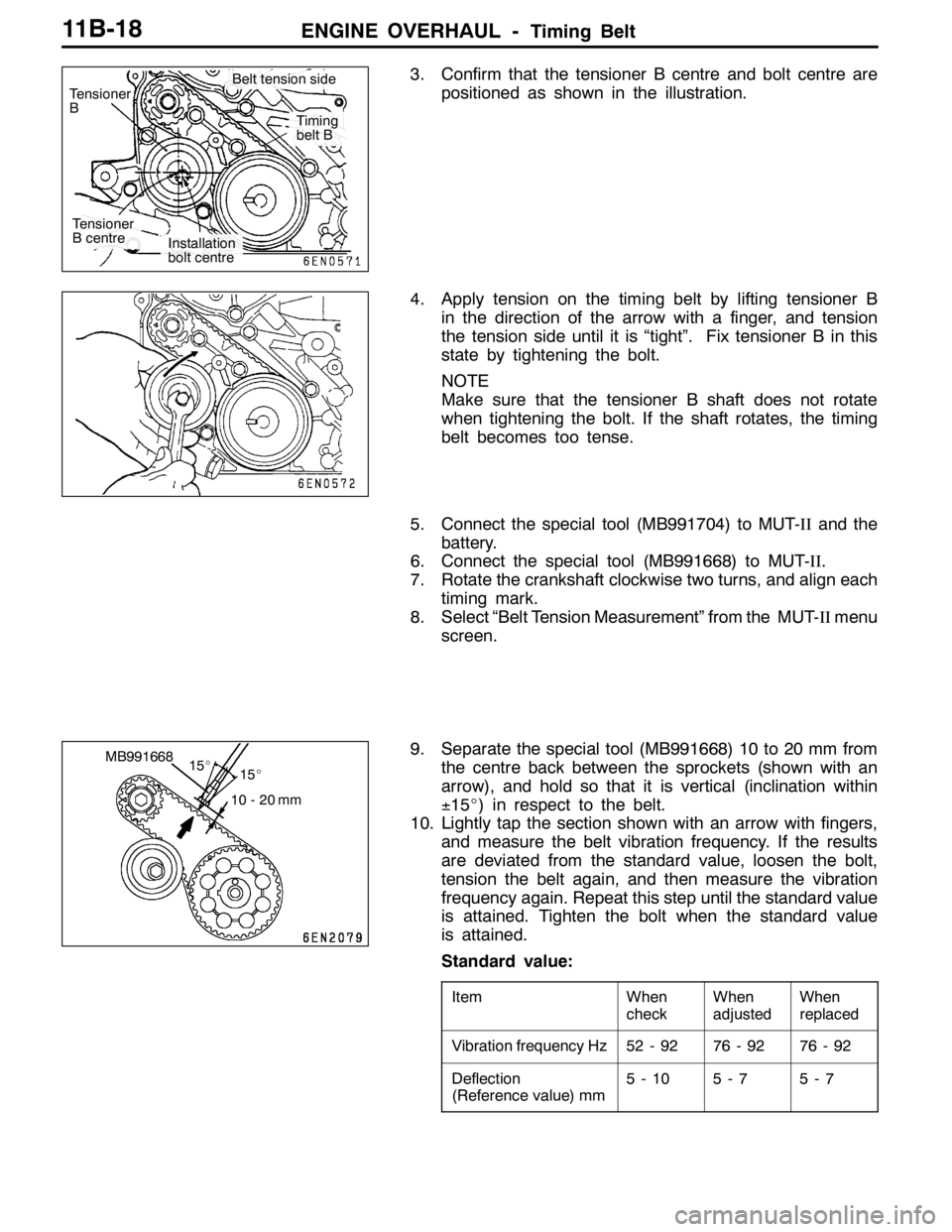2007 MITSUBISHI LANCER EVOLUTION check engine light
[x] Cancel search: check engine lightPage 415 of 1449

ENGINE -On-vehicle ServiceENGINE -On-vehicle Service11A-9
IGNITION TIMING CHECK
1. Before inspection, set the vehicle to the pre-inspection
condition.
2. Turn the ignition switch to “LOCK” (OFF) position and
then connect the MUT-IIto the diagnosis connector.
3. Set up a timing light.
4. Start the engine and run at idle.
5. Check that engine idle speed is within the standard value.
Standard value: 850±100 r/min
6. Select No.17 of the MUT-IIActuator test.
7. Check that basic ignition timing is within the standard
value.
Standard value: 5_BTDC±3_
8. If the basic ignition timing is outside the standard value,
inspect the MPI system while referring to GROUP 13A
- Troubleshooting.
9. Press the MUT-IIclear key (Select a forced driving cancel
mode) to release the Actuator test.
Caution
If the test is not cancelled, a forced driving will
continue for 27 minutes. Driving under this condition
may damage the engine.
10. Check that ignition timing is at the standard value.
Standard value: approximately 5_BTDC
NOTE
(1) Ignition timing is variable within about±7, even under
normal operating.
(2) And it is automatically further advanced by
approximately 5_from standard value at higher
altitudes.
11. Remove the timing light.
12. Turn the ignition switch to “LOCK” (OFF) position and
then remove the MUT-II.
IDLE SPEED CHECK
1. Before inspection, set the vehicle to the pre-inspection
condition.
2. Turn the ignition switch to “LOCK” (OFF) position, and
then connect the MUT-IIto the diagnosis connector.
3. Set the timing light.
4. Check that the basic ignition timing is within the standard
value.
MUT-II
MUT-II
Page 416 of 1449

ENGINE -On-vehicle ServiceENGINE -On-vehicle Service11A-10
Standard value: 5_BTDC±3_
5. Run the engine at idle for 2 minutes.
6. Check the idle speed. Select item No. 22 and take a
reading of the idle speed.
Curb idle speed: 850±100 r/min
NOTE
The idle speed is controlled automatically by the idle speed
control (ISC) system.
7. If the idle speed is outside the standard value, check
the MPI components by referring to GROUP 13A -
Troubleshooting.
8. Remove the timing light.
9. Turn the ignition switch to the “LOCK” (OFF) position
and then remove the MUT-II.
IDLE MIXTURE CHECK
1. Before inspection, set the vehicle to the pre-inspection
condition.
2. Turn the ignition switch to the “LOCK” (OFF) position,
and then connect the MUT-IIto the diagnosis connector.
3. Set the timing light.
4. Check that the basic ignition timing is within the standard
value.
Standard value: 5_BTDC±3_
5. Run the engine at 2,500 r/min for 2 minutes.
6. Set the CO, HC tester.
7. Check the CO contents and the HC contents at idle.
Standard value
CO contents: 0.1% or less
HC contents: 100 ppm or less
8. If there is a deviation from the standard value, check the
following items:
DDiagnosis output
DClosed-loop control (When the closed-loop control
is normal, the output signal of the oxygen sensor
changes between 0 - 400 mV and 600 - 1,000 mV
at idle.)
DFuel pressure
DInjector
DIgnition coil, spark plug cable, spark plug
DEvaporative emission control system
DCompression pressure
NOTE
Replace the three way catalyst when the CO and HC
contents are not within the standard value, even though
the result of the inspection is normal on all items.
9. Remove the timing light.
MUT-II
Page 449 of 1449

ENGINE -Engine Assembly11A-43
ENGINE ASSEMBLY
REMOVAL AND INSTALLATION
Caution
1. If the vehicle is equipped with the Brembo disc brake, during maintenance, take care not to
contact the parts or tools to the caliper because the paint of caliper will be scratched.
2. Tightening sections indicated in the mark (*) should be finally tightened with engine weight
applied on the body after lightly tightening.
Pre-removal and Post-installation Operation
DFuel Outflow Preventive Operation (Refer to GROUP 13A - On-vehicle Service.)
DFuel Leak Check
DRemoval and Installation of Hood (Refer to GROUP 42.)
DRemoval and Installation of Strut Tower Bar (Refer to GROUP 42.)
DRemoval and Installation of Under Cover (Refer to GROUP 51 - Front Bumper.)
DRemoval and Installation of Side Cover.
DDrive Belt Tension Check (Refer to P.11A - 7.)
DAccelerator Cable Adjustment (Refer to GROUP 17 - On-vehicle Service.)
DDrainage and Refilling Engine Oil(Refer to GROUP 12 - On-vehicle Service.)
DDrainage and Refilling of Engine Coolant (Refer to GROUP 14 - On-vehicle Service.)
DAir Cleaner Removal and Installation (Refer to GROUP 15)
DRemoval and Installation of Air Pipe C, Air Pipe B and Air Hose A (Refer to GROUP 15 - Intercooler.)
DBattery and Battery Tray Removal and Installation
DRemoval and Installation of Center Cover (Refer to P.11A - 17.)
DRemoval and Installation of Accelerator Cable (Refer to GROUP 17.)
DRemoval and Installation of Radiator (Refer to GROUP 14.)
DRemoval and Installation of Crossmember Bar (Refer to GROUP 32 - Engine Roll Stopper, Centermember.)
DRemoval and Installation of Front Exhaust Pipe (Refer to GROUP 15.)
DRemoval and Installation of Air Outlet Fitting (Refer to GROUP 15 - Exhaust manifold.)
Page 472 of 1449

ENGINE OVERHAUL -Timing Belt11B-18
3. Confirm that the tensioner B centre and bolt centre are
positioned as shown in the illustration.
4. Apply tension on the timing belt by lifting tensioner B
in the direction of the arrow with a finger, and tension
the tension side until it is “tight”. Fix tensioner B in this
state by tightening the bolt.
NOTE
Make sure that the tensioner B shaft does not rotate
when tightening the bolt. If the shaft rotates, the timing
belt becomes too tense.
5. Connect the special tool (MB991704) to MUT-IIand the
battery.
6. Connect the special tool (MB991668) to MUT-II.
7. Rotate the crankshaft clockwise two turns, and align each
timing mark.
8. Select “Belt Tension Measurement” from the MUT-IImenu
screen.
9. Separate the special tool (MB991668) 10 to 20 mm from
the centre back between the sprockets (shown with an
arrow), and hold so that it is vertical (inclination within
±15_) in respect to the belt.
10. Lightly tap the section shown with an arrow with fingers,
and measure the belt vibration frequency. If the results
are deviated from the standard value, loosen the bolt,
tension the belt again, and then measure the vibration
frequency again. Repeat this step until the standard value
is attained. Tighten the bolt when the standard value
is attained.
Standard value:
ItemWhen
checkWhen
adjustedWhen
replaced
Vibration frequency Hz52 - 9276 - 9276 - 92
Deflection
(Reference value) mm5-105-75-7
Tensioner
B centre
Installation
bolt centre
Timing
belt B
Belt tension side
Tensioner
B
MB991668
15_ 15_
10 - 20 mm
Page 477 of 1449

ENGINE OVERHAUL -Timing Belt11B-23
14. Using the special tool, rotate the tensioner pulley in the
counterclockwise direction to tense the timing belt, and
then fix by temporarily tightening the tensioner fixing bolt.
NOTE
Remove the deflection of the timing belt between the
intake side and exhaust side camshafts.
15. Rotate the crankshaft in the clockwise direction, and set
the timing mark at the No. 1 cylinder compression top
dead centre.
16. Set the special tool, and screw it in until the wire inserted
when the auto tensioner was installed slightly moves.
17. Loosen the tensioner pulley fixing bolt.
Caution
The timing belt will loosen at this time due to the
rotation of the intake and exhaust camshafts, so make
sure that the timing belt does not deviate.
18. Rotate the special tool and torque wrench in the
counterclockwise direction to remove the timing belt
deflection.
19. From that state, return to the position where the torque
wrench scale reads 3.5 N•m, and then tighten the fixing
bolt.
20. Remove the special tool installed in step 16.
21. Rotate the crankshaft two rotations in the clockwise
direction, and let stand for approx. 15 minutes.
22. Confirm whether the wire inserted when the auto tensioner
was installed can be pulled out easily. If it can be removed
easily, the belt tension is appropriate, so remove the wire.
If the auto tensioner rod’s protrusion amount is at the
standard value, the tension is appropriate.
Standard value: 3.8 - 4.5 mm
23. If the wire cannot be pulled out easily, repeat steps 16
to 21, and tense the belt to the appropriate tension.
Caution
When the crankshaft bolt has been rotated in the
counterclockwise direction, always check the crank-
shaft bolt’s tightening torque. If loosen, re-tighten.
MD998767
MD998738
MD998767
Protru-
sion
amount
Page 634 of 1449
![MITSUBISHI LANCER EVOLUTION 2007 Service Repair Manual MPI -Troubleshooting13A-102
DATA LIST REFERENCE TABLE
NOTE
*1. In a new Vehicle [driven approximately 500 km or less], the air flow sensor output frequency time
is sometimes 10% longer than the standa MITSUBISHI LANCER EVOLUTION 2007 Service Repair Manual MPI -Troubleshooting13A-102
DATA LIST REFERENCE TABLE
NOTE
*1. In a new Vehicle [driven approximately 500 km or less], the air flow sensor output frequency time
is sometimes 10% longer than the standa](/manual-img/19/57084/w960_57084-633.png)
MPI -Troubleshooting13A-102
DATA LIST REFERENCE TABLE
NOTE
*1. In a new Vehicle [driven approximately 500 km or less], the air flow sensor output frequency time
is sometimes 10% longer than the standard time.
*2. The injector drive time represents the time when the cranking speed is at 250 r/min or below when
the power supply voltage is 11 V.
*3. In a new vehicle [driven approximately 500 km or less], the injector drive time is sometimes 10%
longer than the standard time.
*4. In a new vehicle [driven approximately 500 km or less], the step of the stepper motor is sometimes
30 steps greater than the standard value.
Item
No.Inspection
itemInspection contentsNormal conditionInspection
procedure
No.Reference
page
11Oxygen
sensor
(front)Engine: After having
warmed up
(Air/fuel mixuture is
made leaner whenWhen at 4,000 r/min,
engine is suddenly de-
celerated200 mV or lessCode No.
P013013A-24
madeleanerwhen
decelerating, and is
made richer when rac-
ing.)When engine is sud-
denly raced600 - 1,000 mV
Engine: After having
warmed up
(The oxygen sensor
(front) signal is used
tochecktheair/fuel
Engine is idling400 mV or less↔
600 - 1,000 mV
(Varies)
to check the air/fuel
mixture ratio, and
control condition is
also checked by the
engine-ECU.)2,500 r/min
12Air flow
sensor*1DEngine coolant
temperature:
Idle operation17 - 43 Hz--
sensor*1temperature:
80 - 95_C
DLightningandall
2,500 r/min40 - 100 Hz
DLightning andall
accessories:
OFF
DTransmission:
NeutralAccelerationAccording to ac-
celeration, fre-
quency is ampli-
fied.
13Intake air
temperature
sensor
Ignition switch: “ON”
or engine runningWhen intake air temper-
ature is - 20_C-20_CCode No.
P011013A-13
sensorWhen intake air tem-
perature is 0_C0_C
When intake air tem-
perature is 20_C20_C
When intake air tem-
perature is 40_C40_C
When intake air tem-
perature is 80_C80_C
Page 639 of 1449

MPI -Troubleshooting13A-107
ACTUATOR TEST REFERENCE TABLE
Item
No.Inspection
itemDrive contentsInspection contentsNormal conditionInspection
procedure
No.Reference
page
01InjectorsCut fuel to No.
1 injectorEngine: After having warmed
up/Engine is idling
(C tthfllth
Idling condition
becomes different
(becomesunsta
Code No.
P020113A-30
02Cut fuel to No.
2 injector(Cut the fuel supply to each
injector in turn and check
cylinders which don’t affect
idli )
(becomes unsta-
ble).Code No.
P020213A-31
03Cut fuel to No.
3 injector
y
idling.)Code No.
P020313A-32
04Cut fuel to No.
4 injectorCode No.
P020413A-33
07Fuel pumpFuel pump
operates and
fuel is recircu-
lated.DEngine:
Cranking
DFuel
pump:
Forced
driving
Inspect
according
Pinch the
return hose
with fingers
to feel the
pulse of the
fuel being
recirculated.Pulse is felt.Procedure
No. 2313A-85
according
to both
the above
conditions.
Listen near
the fuel tank
for the
sound of
fuel pump
operation.Sound of opera-
tion is heard.
08Purge
control
solenoid
valveSolenoid valve
turns from
OFF to ON.Ignition switch: “ON”Sound of opera-
tion can be heard
when solenoid
valve is driven.Code No.
P044313A-41
09Fuel
pressure
control
solenoid
valveSolenoid valve
turns from
OFF to ON.Ignition switch: “ON”Sound of opera-
tion can be heard
when solenoid
valve is driven.Code No.
P110513A-48
10EGR con-
trol sole-
noid valveSolenoid valve
turns from
OFF to ON.Ignition switch: “ON”Sound of opera-
tion can be heard
when solenoid
valve is driven.Code No.
P040313A-39
12Waste
gate sole-
noid valveSolenoid valve
turns from
OFF to ON.Ignition switch: “ON”Sound of opera-
tion can be heard
when solenoid
valve is driven.Code No.
P110413A-47
13Fuel pump
relay 3Fuel pump
relay 3 turns
from OFF to
ON.DIgnition switch: “ON”
DListen near the fuel tank
for the sound of fuel pump
operation.Sound of opera-
tion is heard.Procedure
No. 2313A-85
17Basic igni-
tion timingSet to ignition
timing
adjustment
modeEngine: Idling
Timing light is set5_BTDC--
Page 641 of 1449

MPI -TroubleshootingMPI -Troubleshooting13A-109
Engine-ECU Connector Terminal Arrangement
Terminal No.Check itemCheck condition (Engine condition)Normal condition
1No. 1 injectorWhile engine is idling after having warmed up,
suddenlydepresstheacceleratorpedal
From 11 - 14 V, momentarily
dropsslightly
14No. 2 injector
suddenlydepressthe accelerator pedal.drops slightly
2No. 3 injector
15No. 4 injector
3Fuel pressure control
solenoidvalve
Ignition switch: “ON”System voltage
solenoidvalve
Engine: Cranking→Idle operation
(within approximately 2 minutes or less)1 V or less→System voltage
4Stepper motor coil
startedSystem voltage↔0-6V
(Changes repeatedly)
17Stepper motor coil
5Stepper motor coil
18Stepper motor coil
6EGR control solenoid
valve
Ignition switch: “ON”System Voltage
valve
While engine is idling, suddenly depress the
accelerator pedal.From system voltage,
momentarily drops
8A/C relayDEngine: Idle operation
DA/Cswitch:OFF→ON(A/Ccompressor
System voltage or momen-
tarily6Vormore→1VorDA/Cswitch:OFF→ON(A/Ccompressor
runs)tarily6Vor more→1Vor
less
9Purge control sole-
noidvalve
Ignition switch: “ON”System voltage
noidvalve
Engine: Idle operation1 V or less
10Ignition coil - No.1,
No.4Engine speed: 3,000 r/min0.3 - 3.0 V
23Ignition coil - No.2,
No.3
11Waste gate solenoid
valve
Ignition switch: “ON”System voltage
valve
Engine: After warm-up, idle operation
(When using premium gasoline)1 V or less